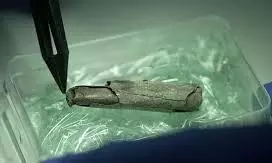
1,800-year-old silver amulet unearthed in Germany alters early Christian history
text_fieldsA third-century grave near Frankfurt, Germany, has yielded a rare silver amulet that offers new insights into the spread of Christianity in the Roman Empire.
Dated between AD 230 and 270, the artefact contains an 18-line Latin inscription and is now considered the earliest evidence of Christianity north of the Alps. The discovery was announced by the Leibniz Center for Archaeology (LEIZA) in a study published on December 11.
The amulet, measuring just 3.5 centimetres, was found in a cemetery on the outskirts of Frankfurt. It was recovered from the grave of a man, with the silver sheet likely worn on a cord around his neck. The placement of the amulet, beneath the man’s chin, suggests it was used as a protective charm.
Researchers employed advanced conservation techniques, including high-resolution CT scanning, to reveal the Latin text. Markus Scholz, an archaeologist at Goethe University, deciphered the inscription, which includes Christian phrases that invoke Saint Titus, Jesus Christ, and passages from Christian scripture such as Philippians.
What sets this amulet apart is its exclusive use of Latin, contrasting with similar artefacts from the eastern Mediterranean, which often feature Greek or Hebrew inscriptions. Dr. Tine Rassalle, a biblical archaeologist, noted that such items were rare in the western Roman Empire, making this find particularly significant.
The amulet includes phrases like “Holy, holy, holy!” which indicate the presence of Christian liturgical practices earlier than previously thought.
The discovery challenges existing timelines of Christianity’s expansion, suggesting the faith had reached the northern regions of the Roman Empire by the third century. It also sheds light on the risks early Christians faced, as persecution under Roman rule often forced them to practice their faith in secrecy.
Similar discoveries, such as a comparable artefact found in Bulgaria, support the idea of Christianity’s far-reaching influence during this period.
Frankfurt Mayor Mike Josef called the amulet a transformative find that redefines the region’s Christian history, extending its timeline back by several decades.























